Every country in the Pacific, as well as Timor-Leste, has some level of formal social protection system. Yet, these systems are poorly understood globally, and are often, perhaps unfairly, judged as being nascent.
That is the context for recent research commissioned by the Australian Government through their Partnerships for Social Protection (P4SP) program and in partnership with research agency Sustineo, which set out to better understand social protection research and evidence in the Pacific and Timor-Leste. Across an analysis of 242 documents, the Evidence Review found there is a significant body of research on social protection in the region from a range of sources, but there are also gaps in understanding.
Social protection includes programs that protect vulnerable population groups from negative impacts and pursue positive societal changes for people in these groups. It is broadly agreed to include social assistance (government-financed schemes) and social insurance (contributory programs like provident funds or superannuation).
The review found formal social protection systems in the Pacific and Timor-Leste are relatively underdeveloped compared to other regions. One study found that total expenditure on social protection as a percentage of gross domestic product (GDP) in Oceania was lower than the average for South-East Asia, and far below the global average for developing countries. (Oceania consists of American Samoa, Australia, Cook Islands, Fiji, French Polynesia, Guam, Kiribati, Marshall Islands, Federated States of Micronesia, Nauru, New Caledonia, New Zealand, Niue, Norfolk Island, Northern Mariana Islands, Palau Islands, Papua New Guinea, Samoa, Solomon Islands, Tokelau, Tonga, Tuvalu, Vanuatu, Wallis and Futuna Islands.)
The relatively low average regional figure hides a wide range of variability. Kiribati is one of the highest-spending countries on social protection in the Asia-Pacific region, allocating some 4.1% of Gross National Income (GNI), with a substantial unemployment benefit (Figure 1). Timor-Leste also allocates a substantial share to social protection, though this is dominated by its veteran pension. At the other end of spectrum are Solomon Islands and Vanuatu which provide no social protection coverage for those outside of the provident funds. Papua New Guinea was also in a similar position until recently introducing a child grant, which is a donor-financed initiative. Given that it was a recent grant, it has not yet been picked up in the available budget figures and thus is not reflected in Figure 1.
Figure 1: Expenditure on social protection as a proportion of GNI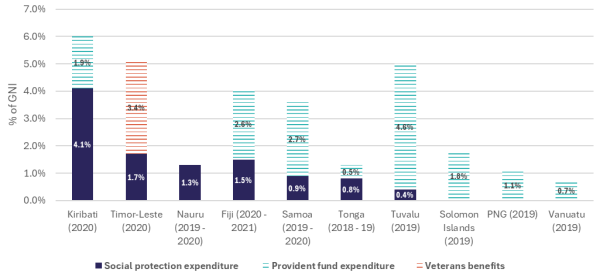
Note: Provident fund expenditure excludes withdrawals permitted in the context of COVID-19. Source: P4SP (2023).
Investment in social protection is gradually increasing across the region. From 2009 onwards, social protection spending (as a percentage of GDP per capita) rose steadily across eight Pacific countries, especially in the latter part of this period. Although expenditure on social insurance continues to rise, reflecting its historical predominance, spending on social assistance is rising faster. This is a positive sign for greater inclusiveness of social protection systems in the Pacific, as traditional social insurance models exclude people who are not in the formal workforce, a significant gap in a region where informal employment dominates. For example, in Vanuatu, 75% of the labour force is not in formal employment, so cannot access traditional social insurance programs.
The shifting mix of expenditure reinforces a previously-identified pattern where countries first introduce social insurance programs and then later introduce social assistance programs, which offer greater coverage of beneficiaries. For example, in response to civil unrest and political instability in 2008, Timor-Leste increased social protection rapidly by implementing the old-age and disability pension and the Bolsa da Mãe program (to support poor and vulnerable households with children).
Across the region, informal social protection systems continue to exist alongside formal structures, often capturing people who cannot access formal social protection systems and providing a base level of resilience to shocks. But escalating shocks, and competing pressures such as modernisation, rising poverty, and loosening social ties, could weaken and overburden these systems. On the other hand, formal social protection systems could offer an opportunity to reach people who are socially excluded. Further investigation to understand the interplay between the two systems and the influence of these relative factors will ensure the systems can complement and reinforce each other for maximum benefit of all community members.
However, who is producing these insights is almost as important as what is being said. The review found most social protection research is led by multilateral organisations like the Asian Development Bank, World Bank and United Nations agencies (Figure 2). These organisations tend to focus on formal, government-led social protection systems — which is to be expected given they tend to work through and with government-led systems. In contrast, research by Pacific organisations, governments and individuals tends to position informal systems of social protection (e.g. wantok, kastom and kerekere) alongside formal social protection systems. This difference in focus implies a disconnect in how social protection in the region is perceived and understood.
Figure 2: Categories of authors represented in the Evidence Review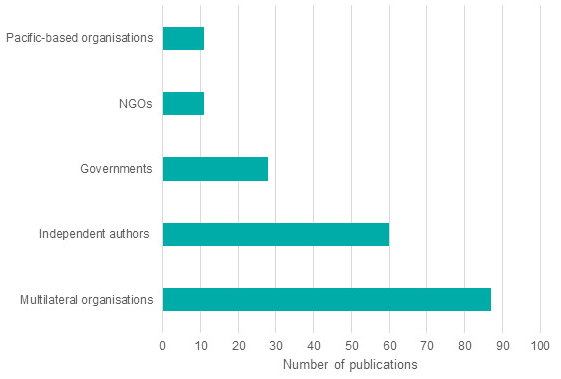
Source: P4SP (2023).
The nature and extent of research also varies across countries. The Evidence Review found some countries, like Fiji and Vanuatu, feature frequently in social protection research, while others are less common or are included primarily in regional level analysis (Figure 3). The differences seem due to factors like level of investment in social protection, scale of international development assistance, and disaster risks.
Figure 3: Coverage of different countries in the social protection literature
Source: P4SP (2023).
In the face of climate change and increasing natural disasters, governments in the Pacific and Timor-Leste are grappling with how to use limited resources to deliver social protection systems that best support their communities. COVID-19 and the escalating impacts of climate change have created a “tipping point” for social protection, by highlighting it as an essential shock response that can sit alongside, and complement, traditional structures. Efforts like this recent review provide a foundation for building understanding and sharing experiences, and guiding future research to account for on-the-ground realities, needs and experiences. Central to expanding and strengthening the evidence base is the need to bolster Pacific and Timorese voices in the literature, ensuring that these local experiences and perspectives are amplified and respected.
You can download the Evidence Review and Annotated Bibliography.
The authors would like to acknowledge the contribution of Jesse Doyle to this blog.

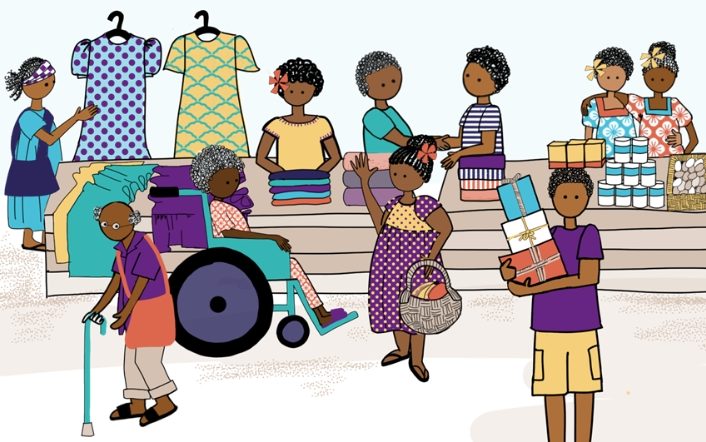
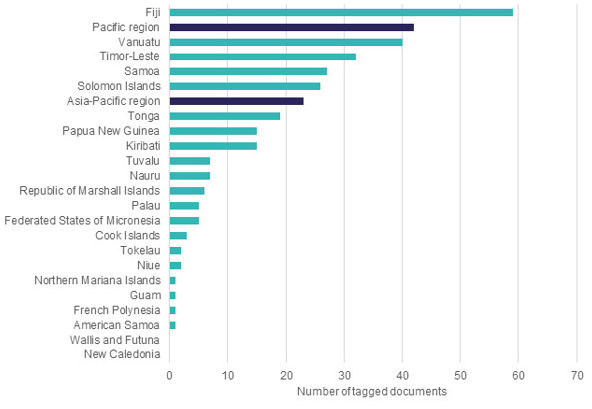
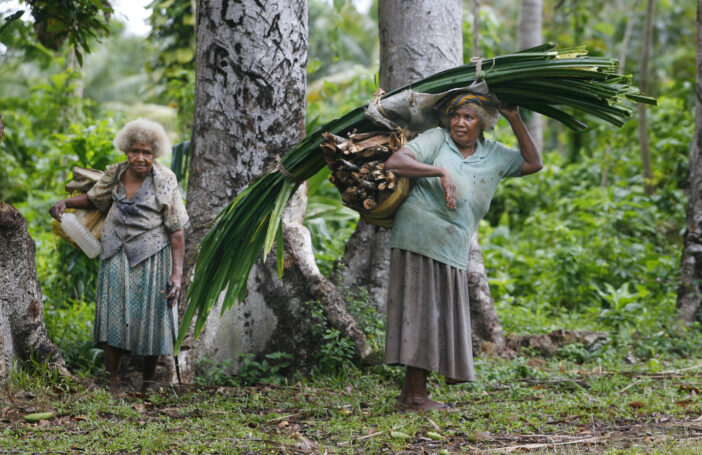
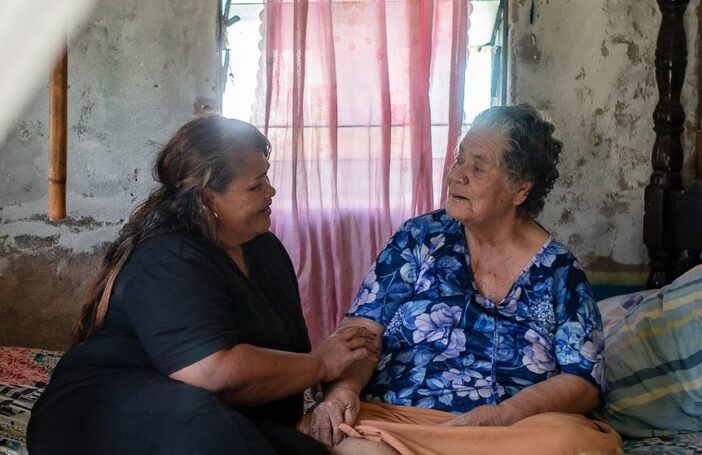


Interesting insights on author representation and the potential for bias in the evidence base!
Were there no publications from university-affiliated authors? I’m surprised that such a category wouldn’t appear in figure 2!
Hi Raphael,
Thanks for your comment. The potential for biases in the evidence due to author representation was a real point of interest to us.
To clarify, university affiliated authors (including individuals publishing through academic journals) were included in the ‘independent authors’ category in Figure 2.